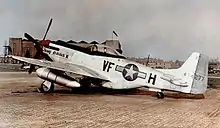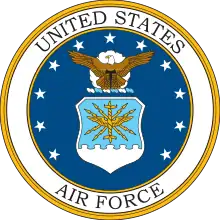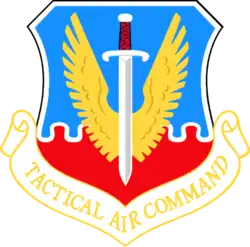336th Fighter Squadron
The 336th Fighter Squadron is a United States Air Force unit. It is assigned to the 4th Operations Group and stationed at Seymour Johnson Air Force Base, North Carolina.
| 336th Fighter Squadron | |
|---|---|
 336th Fighter Squadron F-15E on alert in Afghanistan | |
| Active | 22 August 1942 – present |
| Country | |
| Branch | |
| Type | Fighter |
| Role | Air Interdiction |
| Size | 76 COGs (As of 7 March 2020) |
| Part of | Air Combat Command |
| Nickname(s) | Rocketeers |
| Motto(s) | WFFFFR |
| Colors | Yellow |
| Mascot(s) | The COG |
| Engagements | World War II, Korean War, Vietnam War, Desert Storm, Operations Northern Watch, Operation Southern Watch, Operation Iraqi Freedom, Operation Enduring Freedom |
| Commanders | |
| Current commander | Capt Bobby "Strap" Vaughn |
| Notable commanders | Steven L. "Steep" Turner Carroll W. McColpin Don Gentile Willard W. Millikan Capt Jacob “Spear” DelPonte |
| Insignia | |
| 336th Fighter Squadron emblem (Approved 15 October 1947)[1] |  |
The 336th was constituted on 22 August 1942 as an incorporation of the Royal Air Force 133 Squadron into the United States Army Air Forces' VIII Fighter Command. 133 Squadron was one of three RAF Eagle Squadrons composed of American volunteer pilots who enlisted in the RAF and fought in World War II prior to the United States entry into the war.
At the height of conversion training, the 4th TFW was one of the first units tasked to react to Iraq's invasion of Kuwait in August 1990. The 335th and 336th Tactical Fighter Squadrons and support personnel deployed to Saudi Arabia, beginning in August 1990. The combat record of the 4th TFW in Saudi Arabia was exceptional, with the 336th TFS flying 1,088 combat missions during Operation Desert Storm. The unit dropped more than six-million pounds of bombs on Scud missile sites, bridges and airfields. Most of the missions were flown at night.[2]
Overview
The "Rocketeers" fly the McDonnell-Douglas (now Boeing) F-15E Strike Eagle. It was the first operational F-15E squadron in the Air Force. Its aircraft are identified by the "SJ" tail code and yellow fin flash.
Currently the squadron provides worldwide deployable aircraft and personnel capable of executing combat missions in support of worldwide Aerospace Expeditionary Force deployments to combat areas as part of the Global War on Terrorism. To date, the 336th have destroyed 459 enemy aircraft including the 4th Fighter Wing's sole MiG kill in Vietnam.
History


On 23 September 1942 the 4th Fighter Group moved to its initial airfield at RAF Debden; however, the 336th moved to a satellite field at RAF Great Sampford. They conducted operations from there until rejoining the group at Debden on 30 October 1942.
Fighter aircraft escorted first bombing raid over Berlin, March 1944. On 21 June 1944, escorted bombers in the first shuttle bombing mission from England to Russia. Received Distinguished Unit Citation (DUC) for destroying enemy aircraft and attacking air bases in France, 5 March – 24 April 1944.
In 1946 trained in jet aircraft; participated in air shows around the US; began night flying in late 1947.

Combat in Korea, December 1950 – July 1953. Received second and third DUCs for combat in Korean War, 22 April – 8 July 1951 and 9 July – 27 November 1951.

Deployed to Florida in October 1962 during Cuban missile crisis.
From January–June 1968, deployed to Korea; tasked with operations associated with USS Pueblo incident. Combat in Southeast Asia, April–September 1972 and March 1973.

During the 1980s, trained in combat readiness in order to maintain worldwide commitment and air-to-air mission capability. Deployed to Europe under dual-based mission concept in support of NATO objectives, 1978–1985.

Participated in initial attack on Iraq, 17 January 1991. During 1990–1994, shared quarterly rotation duties to Southwest Asia with 334th and 335th Fighter Squadrons.
Since 1991, trained as combat ready fighter squadron prepared for rapid worldwide deployment of fighter aircraft to accomplish air-to-ground, air-to-air, strategic attack and deep interdiction missions.

Deployed to combat areas in Middle East as part of Global War on Terrorism, 2001–present.
On 18 July 2009, F-15E serial 90-231 from the 336th Fighter Squadron crashed in eastern Afghanistan, killing the two-man crew, Captain Mark R. McDowell and Captain Thomas J. Gramith. The US military reported that the jet was not downed by enemy action.[3]
2013 sequestration
Air Combat Command officials announced a stand down and reallocation of flying hours for the rest of the fiscal year 2013 due to mandatory budget cuts. The across-the board spending cuts, called sequestration, took effect 1 March when Congress failed to agree on a deficit-reduction plan.[4]
Squadrons either stood down on a rotating basis or kept combat ready or at a reduced readiness level called "basic mission capable" for part or all of the remaining months in fiscal 2013.[4] This affected the 336th Fighter Squadron with a stand-down grounding from 9 April-30 September 2013.[4]
Lineage
- Constituted as the 336th Fighter Squadron on 22 August 1942
- Activated on 12 September 1942
- Redesignated 336th Fighter Squadron, Single Engine on 20 August 1943
- Inactivated on 10 November 1945
- Activated on 9 September 1946
- Redesignated 336th Fighter Squadron, Jet Propelled on 23 April 1947
- Redesignated 336th Fighter Squadron, Jet on 14 June 1948
- Redesignated 336th Fighter-Interceptor Squadron on 20 January 1950
- Redesignated 336th Fighter-Bomber Squadron on 8 March 1955
- Redesignated 336th Fighter-Day Squadron on 25 April 1956
- Redesignated 336th Tactical Fighter Squadron on 1 July 1958
- Redesignated 336th Fighter Squadron on 1 November 1991[1][note 4]
Assignments
- 4th Fighter Group, 12 September 1942 – 10 November 1945
- 4th Fighter Group (later 4th Fighter-Interceptor Group, 4th Fighter-Bomber Group, 4th Fighter-Day Group), 9 September 1946
- Attached to 49th Fighter-Bomber Wing, 19 November 1954; 18th Fighter-Bomber Wing, 7 August 1956; 313th Air Division, after 1 February 1957
- 4th Fighter-Day Wing (later 4th Tactical Fighter Wing, 4th) Wing), 8 December 1957
- Attached to 65th Air Division, 12 August 1963 – 7 January 1964; Seventeenth Air Force, 25 May–30 August 1965; 8th Tactical Fighter Wing, 12 April–30 September 1972 and 9 March–7 September 1973; 314th Air Division, 22 March–17 April 1977; 86th Tactical Fighter Wing, 11 September–13 October 1978, 31 August–1 October 1979, 26 August–26 September 1980, 5 September–3 October 1983 and 26 August–26 September 1985; 4th Tactical Fighter Wing (Deployed), 9 August–20 December 1990; 4th Tactical Fighter Wing Provisional, 20 December 1990 – c. 13 March 1991
- 4th Operations Group, 22 April 1991 – present[1]
Stations
|
|
Aircraft
|
|
Notable squadron members
Emblems
 133 Eagle Squadron, RAF, 1940
133 Eagle Squadron, RAF, 1940 336th Fighter-Interceptor Squadron
336th Fighter-Interceptor Squadron 336th Expeditionary Fighter Squadron
336th Expeditionary Fighter Squadron
References
Notes
- Explanatory notes
- Aircraft is P-51D-10-NA Mustang serial 44-14277. This aircraft was shot down over Prague 16 April 1945 and the pilot was taken Prisoner of War.
- Aircraft is North American F-100C-1-NA Super Sabre, serial 53-1743. F-100F-10-NA Super Sabres are serials 56-3868 and 56-3842. 56-3842 was sold to Denmark in 1974, later being sold on the civilian marketplace, being registered as N417FS in 1982.
- Aircraft is F-4E-61-MC Phantom serial 74-1629.
- When the squadron is the primary force provider to a deployed expeditionary unit, that unit is designated the 336th Expeditionary Fighter Squadron, a provisional unit.
- Citations
- Robertson, Patsy (11 October 2016). "Factsheet 336 Fighter Squadron (ACC)". Air Force Historical Research Agency. Retrieved 25 July 2018.
- Heidicker, Dr Roy. "4th Fighter Wing History" (PDF). 4th Fighter Wing History Officve. Archived from the original (PDF) on 4 March 2016. Retrieved 10 February 2019.
- No byline (19 July 2009). "Military names 2 who died in F-15 crash". Military Times (reprinting Associated Press story). Archived from the original on 22 February 2012. Retrieved 10 February 2019.
- Everstein, Brian; Weisgerber, Marcus (8 April 2013). "Reduced flying hours forces grounding of 17 USAF combat air squadrons". Military Times. Retrieved 4 October 2016.
- Station number in Anderson.
- Station number in Endicott, pp. 177–178.
- Station information in Robertson, except as noted.
Bibliography
![]() This article incorporates public domain material from the Air Force Historical Research Agency website http://www.afhra.af.mil/.
This article incorporates public domain material from the Air Force Historical Research Agency website http://www.afhra.af.mil/.
- Anderson, Capt. Barry (1985). Army Air Forces Stations: A Guide to the Stations Where U.S. Army Air Forces Personnel Served in the United Kingdom During World War II (PDF). Maxwell AFB, AL: Research Division, USAF Historical Research Center. Archived from the original (PDF) on 23 January 2016. Retrieved 28 June 2017.
- Endicott, Judy G., ed. (2001). The USAF in Korea, Campaigns, Units and Stations 1950–1953 (PDF). Maxwell AFB, AL: Air Force Historical Research Agency. ISBN 0-16-050901-7. Retrieved 17 December 2016.
- Freeman, Roger A. The Mighty Eighth War Diary (1990) Motorbooks International
- The Mighty Eighth: A History of the Units, men and Machines of the US 8th Air Force (1991) Motorbooks International
- The Mighty Eighth War Manual (1991) Motorbooks International
- Maurer, Maurer, ed. (1983) [1961]. Air Force Combat Units of World War II (PDF) (reprint ed.). Washington, DC: Office of Air Force History. ISBN 0-912799-02-1. LCCN 61060979. Retrieved 17 December 2016.
- Maurer, Maurer, ed. (1982) [1969]. Combat Squadrons of the Air Force, World War II (PDF) (reprint ed.). Washington, DC: Office of Air Force History. ISBN 0-405-12194-6. LCCN 70605402. OCLC 72556.
- Ravenstein, Charles A. (1984). Air Force Combat Wings, Lineage & Honors Histories 1947–1977. Washington, DC: Office of Air Force History. ISBN 0-912799-12-9. Retrieved 17 December 2016.
- iCasualties.org: Operation Enduring Freedom http://icasualties.org/OEF/ByNationality.aspx
External links
- 336th Fighter Squadron Official Unit Website Referenced 29 January 2006
- 336th Fighter Squadron GlobalSecurity.org Referenced 29 January 2006
- 4th Fighter Group WWII Official WWII Association Website Referenced 4 March 2012



